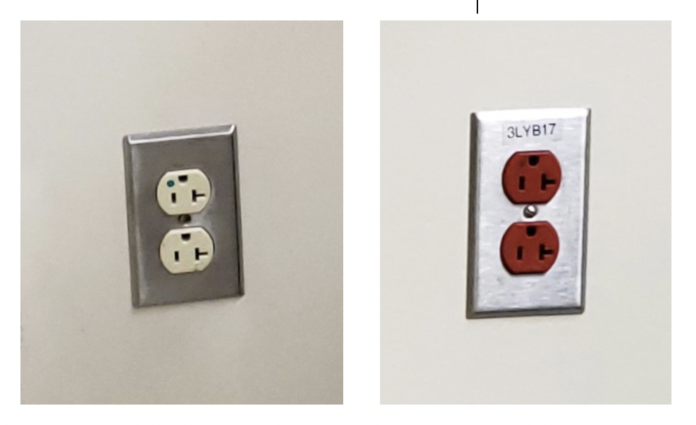Marty, a member of the Knowledge Vine team, and his wife Michelle have been eagerly awaiting the arrival of their first child: a little girl to be named McKinley. Of course, the lead up to this happy event involves many visits to various medical facilities.
 Not unlike most men, while Michelle was dutifully taking in all the pertinent “You’re about to have a little person in your house that will be 100% dependent on you” information, Marty was distracted by the electrical outlets. Why are they different colors? Why are they upside-down? What’s with the little green dot on all the white ones? You know, typical dad questions for the OB-GYN.
Not unlike most men, while Michelle was dutifully taking in all the pertinent “You’re about to have a little person in your house that will be 100% dependent on you” information, Marty was distracted by the electrical outlets. Why are they different colors? Why are they upside-down? What’s with the little green dot on all the white ones? You know, typical dad questions for the OB-GYN.
Rather than researching the safest car seat, he looked into the outlet dilemma. The red outlets are the ones that have an emergency, back-up power supply—typically the hospital generator. The green dot means the outlet has been built to hospital standards: higher reliability, assembly integrity, durability, and strength than standard home outlets. The upside-down part is to prevent inadvertent contact with the energized part of an electrical plug.
These are all examples of error defenses. Make it easier to identify which outlets will have back up power by making them red. Make it easy to ensure the outlet you are using is hospital-grade with the green dot. The upside-down part is a little more nuanced.
The idea is if the plug is partially out, exposing some of the metal, you could contact the energized part of the plug. (Quick refresher here: The round part is the ground. One of the flat parts is the neutral, and the other flat part is the live, hot, or energized piece. You don’t want to contact this part.) If the ground (the round piece) is on the top, then any wires that may have been draped in the same area would contact the ground instead of the live conductor.
The hospital has built in an error defense. We know that people make mistakes and plugs can be left partially exposed, so let’s “fail softly” if that happens. Failing softly just means if things don’t go as planned, at least we can minimize or eliminate the impact. It’s like the airbags and seatbelts in your car. The first line of defense is good driving, but if that fails and you get in an accident, the impact of this failure is lessened as the airbags and seatbelts do their job to protect life and limb.
In the case of the upside-down plug, the first line of defense should be to ensure all plugs are inserted fully. If you know a worker in the medical field, ask them why the plugs are upside-down. Odds are they don’t know.
This brings up two questions. First, if it is important enough to make this outlet orientation a hospital standard, then why haven’t the hospitals informed their workforce about it? After all, this is the second line of defense—the back-up plan. The first line should be “check that the plugs are fully inserted,” but we never told the workers about the potential danger we have designed the plugs against. The second question is, if upside-down plugs are inherently safer, then why aren’t we doing that everywhere and not just in hospitals?
Don’t rely on the back-up plan. Make sure your first line of defense is understood and in place. Gloves will protect your hands, but keeping them out of the line of fire is your first defense.
By the way, congratulations to Michelle and Marty. This past Saturday they welcomed baby McKinley into the family. Mom and baby are doing great, and Michelle figured out that car seat thing herself.
Toolbox Talks offers quick insights and thoughts to use for your toolbox (tailboard) talks. Dave Sowers is a founding member of Knowledge Vine, a veteran-owned human performance training and consulting organization that strives to reduce the frequency and severity of human errors in the workplace. He has almost 30 years of experience in power generation and the utility industry. He is a veteran of U.S. Navy Nuclear Power Program and holds a bachelor’s degree in resources management and a master’s degree in both management and emergency management and homeland security.



